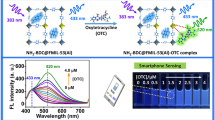Abstract
Our observations that 1-[2-[(9-anthracenylmethylamino)ethyl)-4,7,10-tris[(2S)-2-hydroxy-3-phenoxypropyl]-1,4,7,10-tetraazacyclododecane, L1, complexes Cd(II) to form fluorescent [CdL1]2+ which undergoes a fluorescence change when it acts as an aromatic anion receptor complex has caused us to explore further the potential development of an interesting sequestration/sensor system. Accordingly, three new, octadentate, fluorescent, macrocyclic ligands, 1-[2-[(9-anthracenylmethyl)((2S)-2-hydroxy-3-phenoxypropyl)amino]ethyl]-4,7,10-tris[(2S)-2-hydroxy-3-phenoxypropyl]-1,4,7,10-tetraazacyclododecane, (L2), 1-[2-[(9-anthracenyl-methyl)((2S)-2-hydroxy-3-(4′-methyl)phenoxypropyl)amino]ethyl]-4,7,10-tris[(2S)-2-hydroxy-3-(4′-methyl)phenoxypropyl]-1,4,7,10-tetraazacyclododecane, (L3), and 1-[2-[(9-anthracenylmethyl)((2S)-2-hydroxy-3-(4′-t-butyl)phenoxypropyl)amino]ethyl]-4,7,10-tris[(2S)-2-hydroxy-3-(4′-t-butyl)phenoxypropyl]-1,4,7,10-tetraazacyclododecane, (L4), have been prepared with a view to using their metal complexes to study aromatic anion sequestration. The eight-coordinate Cd(II) complexes of L2 and L3, [CdL2](ClO4)2·5H2O and [CdL3](ClO4)2·2H2O·2Et2O are both capable of acting as receptors for a range of aromatic oxoanions. This is demonstrated by perturbation of the anthracene derived fluorescence emission intensity as the guest aromatic oxoanion and the receptor complex combine. In 20% aqueous 1,4-dioxane the receptor complex/aromatic oxoanion association constants are in the range of 103.2 M−1 (guest = p-hydroxybenzoate) to 107.3 M−1 (guest = 3,4,5-trihydroxybenzoate).





Similar content being viewed by others
References
Smith, C.B., Wallwork, K.S., Weeks, J.M., Buntine, M.A., Lincoln, S.F., Taylor, M.R., Wainwright, K.P.: Metal ion dependent molecular inclusion chemistry:inclusion of p-toluenesulfonate and p-nitrophenolate within the structure of coordinated 1, 4, 7, 10-tetrakis((S)-2-hydroxy-3-phenoxypropyl)-1, 4, 7, 10-tetraazacyclododecane. Inorg. Chem. 38, 4986–4992 (1999)
Wainwright, K.P.: Applications for polyaza macrocycles with nitrogen-attached pendant arms. Adv. Inorg. Chem. 52, 293–334 (2001)
Smith, C.B., Stephens, A.K.W., Wallwork, K.S., Lincoln, S.F., Taylor, M.R., Wainwright, K.P.: Metal ion-dependent molecular inclusion chemistry:inclusion of aromatic anions by coordinated 1, 4, 7, 10-tetrakis((S)-2-hydroxy-3-phenoxypropyl)-1, 4, 7, 10-tetraazacyclododecane. Inorg. Chem. 41, 1093–1100 (2002)
Robinson, T.S., Wyness, O., Lincoln, S.F., Taylor, M.R., Tiekink, E.R.T., Wainwright, K.P.: A structural study of the synergic envelopment of acetonitrile by a Cd(II) activated molecular receptor formed from cyclen with appended 2-hydroxy-3-phenylpropyl moieties. Inorg. Chim. Acta 359, 1413–1420 (2006)
Damsyik, A., Lincoln, S.F., Wainwright, K.P.: Synthesis and characterisation of water-operative cationic and anionic metal-ion activated molecular receptors for aromatic anions. Inorg. Chem. 45, 9834–9842 (2006)
Bradbury, A.J., Lincoln, S.F., Wainwright, K.P.: Fluorescent signalling provides deeper insight into aromatic anion uptake by metal ion activated molecular receptors. New J. Chem. 32, 1500–1508 (2008)
Hodyl, J.A.Z., Lincoln, S.F., Wainwright, K.P.: Silica-attached molecular receptor complexes for benzoates and naphthoates. J. Incl. Phenom. Macrocycl. Chem. 68, 261–270 (2010)
Jeffrey, G.A.: An Introduction to Hydrogen Bonding. Oxford University Press, Oxford (1997)
Plush, S.E., Lincoln, S.F., Wainwright, K.P.: Fluorescent ligands derived from 2-(9-anthrylmethylamino)ethyl-appended cyclen for use in metal ion activated molecular receptors. Inorg. Chim. Acta. 362, 3097–3103 (2009)
Aoki, S., Kaido, S., Fujioka, H., Kimura, E.: A new zinc(II) fluorophore 2-(9-anthrylmethylamino)ethyl-appended 1, 4, 7, 10-tetraazacyclododecane. Inorg. Chem. 42, 1023–1030 (2003)
Geue, J.P., Head, N.J., Ward, A.D., Lincoln, S.F.: Complexation of alkali metal and alkaline earth metal ions by anthracene based fluorophores with one and two appended monoaza coronand receptors. J. Chem. Soc. Dalton Trans. 4, 521–526 (2003)
March, J.: Advanced Organic Chemistry, 3rd edn, p. 234. Wiley-Interscience, New York (1985)
Akkaya, E.U., Huston, M.E., Czarnik, A.W.: Chelation-enhanced fluorescence of anthrylazamacrocycle conjugate probes in aqueous solution. J. Am. Chem. Soc. 112, 3590–3593 (1990)
Huang, X., Lu, Y., He, Y., Chen, Z.: A metal-macrocycle complex as a fluorescent sensor for biological phosphate ions in aqueous solution. Eur. J. Org. Chem. 2010, 1921–1927 (2010)
Ji, H., Dabestani, R., Brown, G.M., Hettich, R.L.: Synthesis and sensing behaviour of cyanoanthracene modified 1, 3-alternate calix[4]benzocrown-6: a new class of Cs + selective optical sensors. J. Chem. Soc. Perkin Trans. 2, 585–591 (2001)
Xu, H., Xu, X., Dabestani, R., Brown, G.M., Fan, L., Patton, S., Ji, H.: Supramolecular fluorescent probes for the detection of mixed alkali metal ions that mimic the function of integrated logic gates. J. Chem. Soc. Perkin Trans. 2, 636–643 (2002)
De Santis, G., Fabbrizzi, L., Licchelli, M., Taglietti, A.: Molecular recognition of carboxolate ions based on metal-ligand interaction and signalled through fluorescence quenching. Angew. Chem. Int. Ed. Engl. 35, 202–204 (1996)
Callan, J.F., De Silva, A.P., McClenaghan, N.D.: Switching between molecular switch types by module rearrangement: Ca2+-enabled, H+-driven ‘Off-On-Off’, H+-driven YES and PASS 0 as well as H+, Ca2+-driven AND logic operations. Chem. Commun. 40, 2048–2049 (2004)
Perrin, D.D., Armarego, W.L.F., Perrin, D.R.: Purification of Laboratory Chemicals, 3rd edn. Pergamon, Oxford (1988)
Demas, J.N., Crosby, G.A.: The measurement of photoluminescent quantum yields. A review. J. Phys. Chem. 75, 991–1024 (1971)
Acknowledgment
Funding of this study by the Australian Research Council is gratefully acknowledged.
Author information
Authors and Affiliations
Corresponding author
Rights and permissions
About this article
Cite this article
Bradbury, A.J., Lincoln, S.F. & Wainwright, K.P. Fluorescence signaling of aromatic oxoanion inclusion within metal-ion activated molecular receptor complexes formed from 2-(9-anthracenylmethylamino)ethyl-appended cyclen. J Incl Phenom Macrocycl Chem 71, 567–575 (2011). https://doi.org/10.1007/s10847-011-9924-7
Received:
Accepted:
Published:
Issue Date:
DOI: https://doi.org/10.1007/s10847-011-9924-7




